Blog/Clienteling/5 Key Functions for WeCom Customer Contact Management
In this article, we will delve into the robust customer contact management capabilities of WeCom (WeChat Work) as a powerful clienteling tool for brands operating in the dynamic China market.
Table of Content
Why WeCom Clienteling in China?
WeCom, formerly known as WeChat Work, is a corporate communication tool developed by Tencent, the parent company of WeChat, China’s leading multi-functional social media platform.
WeCom is best known for its remarkable clienteling capabilities which enable Sales Associates, Client Advisors, and Customer Service staff to seamlessly connect with clients and customers on WeChat.
The interoperability between WeCom and WeChat empowers brands to deliver targeted, relevant, messages from a professional platform, cultivating long-term relationships with high-value clients.
In recent years, WeCom has evolved into a vital extension for brands’ Private Traffic management, which plays a pivotal role in their digital transformation journey in China.
From seamlessly connecting the WeChat ecosystem with physical retail to enhancing data collection, security, and more, WeCom can not only alleviate many challenges in clienteling for the staff level but also provide a much clearer oversight for the management level, including in customer management. In the next sections, we will dive into:
5 Key Functions for WeCom Customer Contact Management
1. “Contact Me” Function
WeCom provides an intuitive “Contact Me” feature for users to seamlessly generate a “Contact Me” WeCom QR code directly from the WeCom backend.
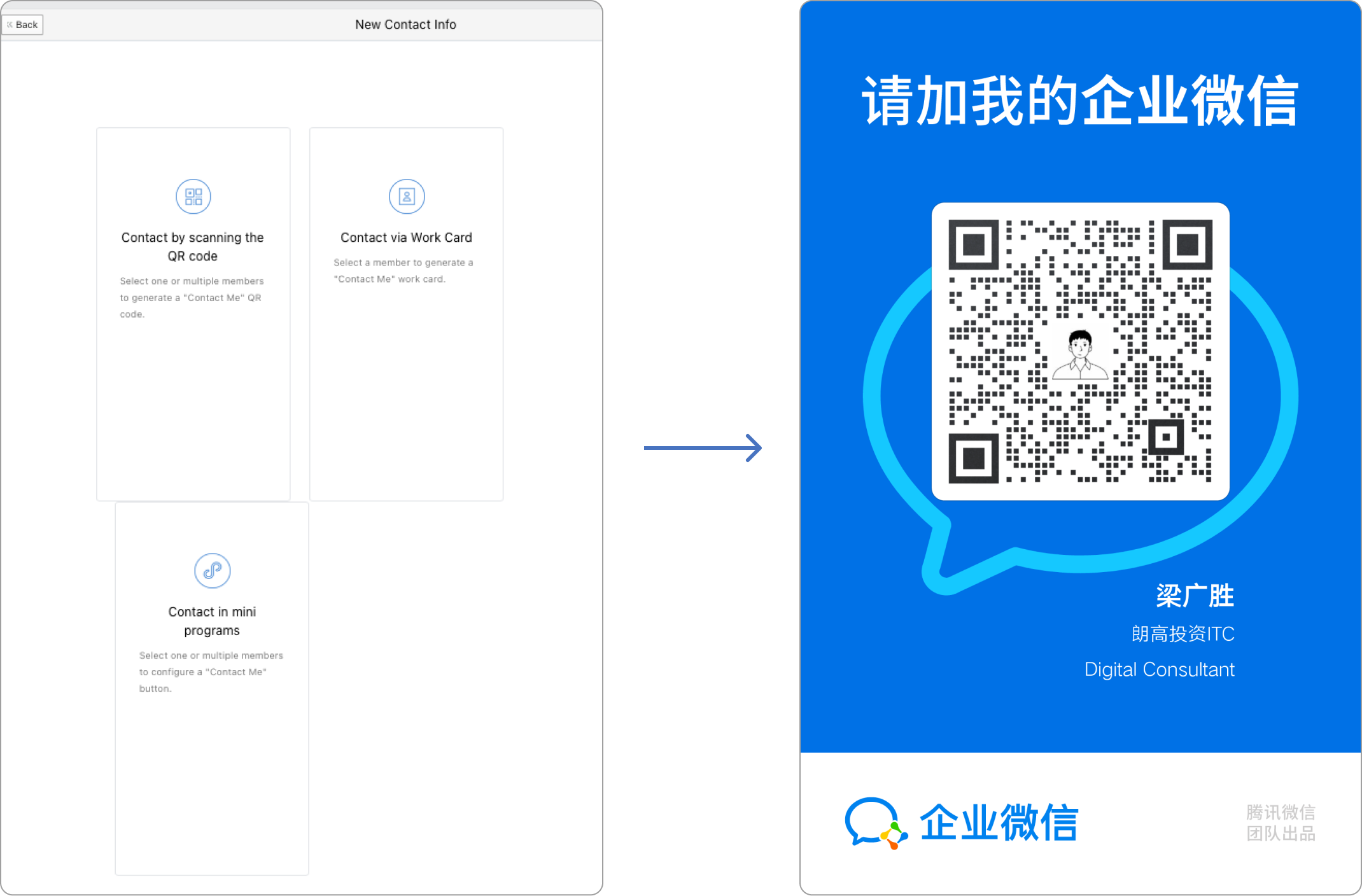
This QR code acts as a bridge, enabling customers to automatically add the WeCom account of the brand’s representative, such as sales associates (SAs), client advisors (CAs), and customer service representatives (CSs), as a friend on WeChat.
The main function of these QR codes is for sales associates to print them out and put them in their name tags for customers to easily scan them during in-store visits.
Another scenario is embedding the QR code into the brand’s WeChat Official Account and Mini Program, particularly within the Store Locator section. However, if there are multiple Sales Associates in a single store, displaying numerous WeCom QR codes may be confusing and counterintuitive.
Instead, we recommend adding the QR code to the Mini Program strategically, such as during exclusive events, to capture more customer data while ensuring a seamless O2O (online-to-offline) customer experience.
One of the most notable reasons why professional WeCom QR codes outweigh personal WeChat QR codes is that:
– WeChat QR code only allows users to show it and get passively added by a maximum of 50 contacts in a day;
– WeCom QR code allows users to get passively added by up to 500 to 1,000 contacts in a day based on the account’s activeness.
2. Customer Details
Now that we have added many customers, what kind of customer information can be retained in the Customer Relationship Management (CRM) system?
WeCom can grant brands access to a treasure trove of customer data. However, with the native WeCom function alone, it is not possible to collect most information. It is only possible for the user to see their:
- Avatar
- WeChat account name (which is distinct from the WeChat ID)
- Gender details
- The time the customer was added
- Contact type (personal WeChat or professional WeCom)
- The source of the connection (e.g., scan QR code, business card sharing, group chat)
For a more in-depth understanding of the customers and their interactions with the brand’s WeCom, generating a parametric WeCom QR code is necessary, supported by third-party tools such as the ITC Clienteling Solution. For example, with different parametric QR codes for different sources and purposes, brands can easily determine where the customers scanned them from.
In addition, ITC Clienteling Solution can equip sales associates with access to more comprehensive customer details, facilitating a deeper understanding of clienteling.
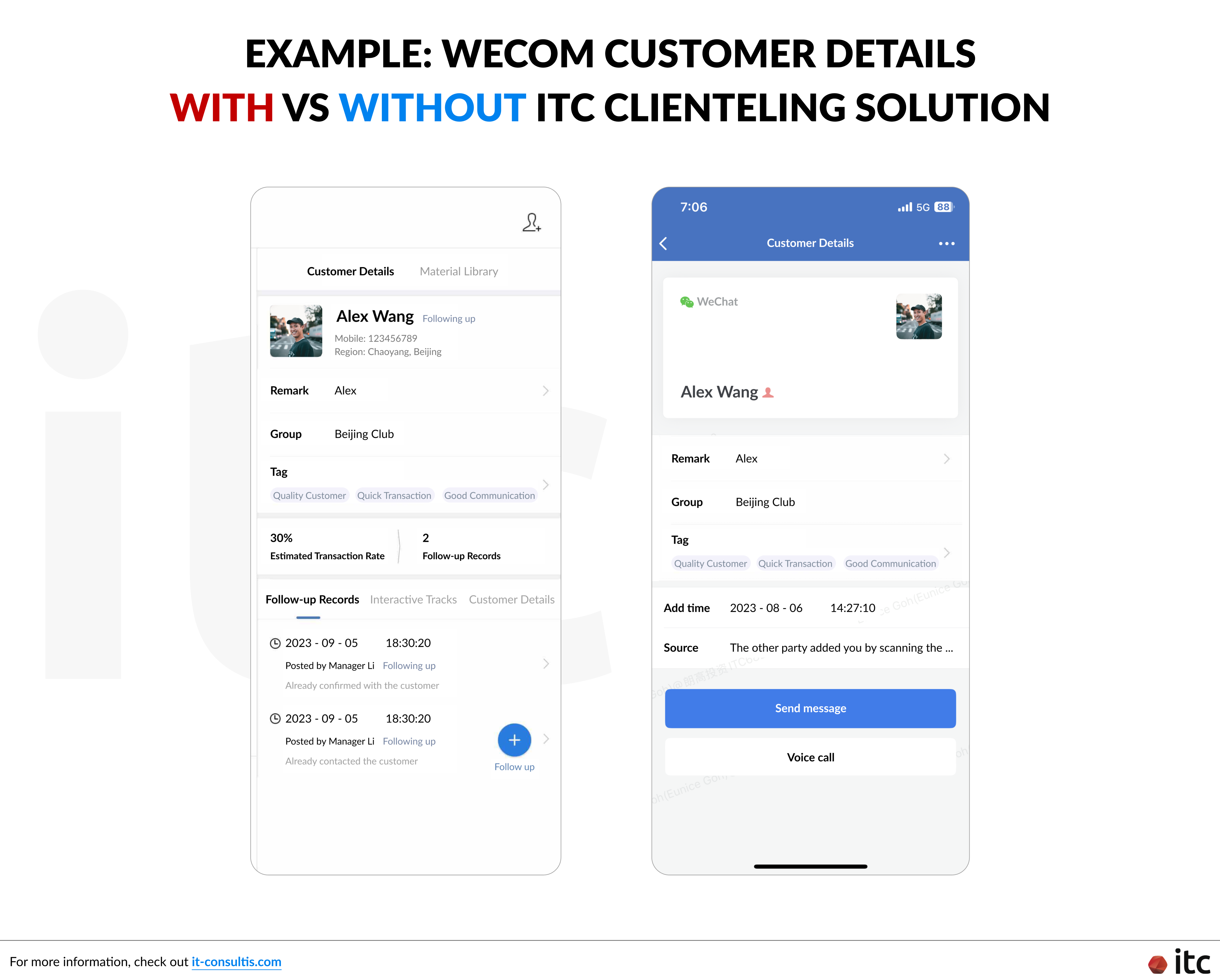
In addition, for a holistic overview, the supporting tool for WeCom can showcase a real-time performance dashboard to track customer growth, churn rate, response rate, average response time, etc.
Users can view different dashboards on the ITC Clienteling Solution, including Customer Statistics and Group Statistics, and filter the WeCom clienteling performance by date or by employee for performance management.
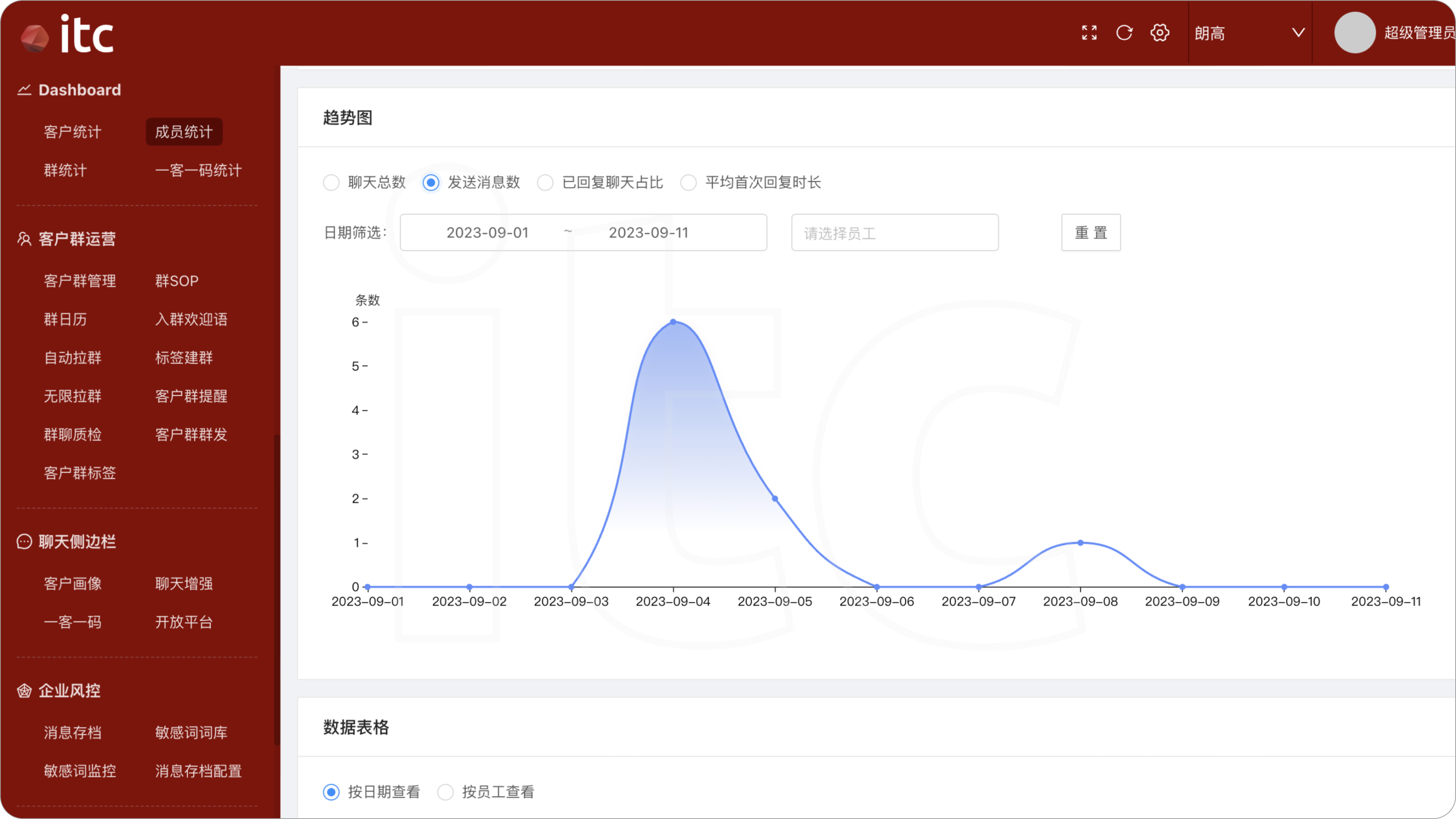
3. Customer Tagging
With a handful of customers to manage at a time, it can be hard and time-consuming for sales associates to keep tabs on each customer’s preferences and behaviors manually, not only for one-on-one interactions but also for mass promotion.
Employing a WeCom tagging strategy with a library of custom tags in various categories offers a more efficient and accurate way to streamline information organization and target or retarget customers in future engagements.
As more customer insights accumulate, additional tags can be added to each customer, refining the labeling structure over time for more personalized content delivery.
Enterprises can seamlessly synchronize customer tags to the CRM system through the WeCom Open API. Alternatively, they can sync their existing CRM system data with the WeCom tag library.
The latter is usually preferred, especially when an enterprise has already amassed a rich repository of customer profiles before setting up their channels on WeChat, such as Official Accounts and Mini Programs.
For instance, if a customer has a consistent pattern of purchasing men clothing at Shanghai stores and is identified as a man, the brand can tag the customer as “Male”, “Men Wear”, “Shanghai”, and “VIP”. This categorization proves invaluable when tailoring communication strategies, allowing the brand to push messages on a new collection for men.
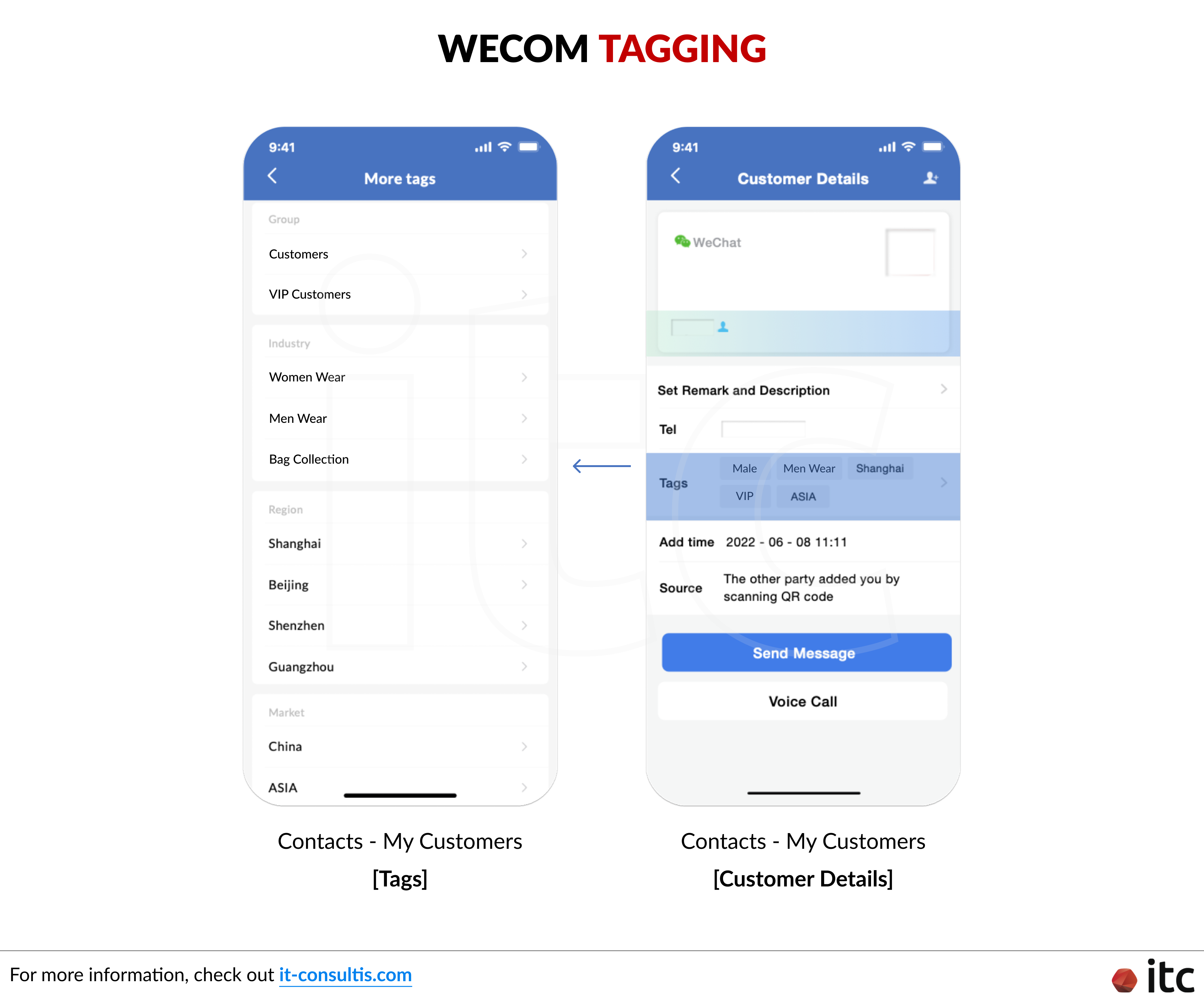
The management of WeCom customer tags is primarily the purview of admins. An additional layer of flexibility from third-party supporting tools, such as the ITC Clienteling Solution, can enable brands to administer more precisely control over who or what department would be able to view or edit a certain tag group, safeguarding against inadvertent misuse or deletion of the enterprise’s customer profiles library.
4. Customer Allocation & Inheritance
Many unanswered questions also arise during staff turnover when sales associates use personal WeChat accounts for clienteling, such as:
- What do you do when your Store Manager leaves? Who would retain the contacts if you do not have a replacement at this specific moment?
- What happens if one of your top sales associates leaves?
- What happens if one of your sales associates deletes their contacts before leaving?
- What happens if one of your managers relocates to another city?
Not only would retaining data be a challenge for the brand but there is also a risk that the former staff may take these customers along with them.
WeCom can streamline the process of customer allocation, particularly when employees resign. Via the WeCom interface, companies can retrieve lists of employees who have resigned and the corresponding timestamps of their departures to facilitate the seamless transfer of customers and their corresponding data.
Each of those discussions will need a specific standard operating procedure (SOP) well-aligned across the HR, Retail, and CRM departments.
After a successful reassignment, brands can send custom messages to the customers to notify them of the change.
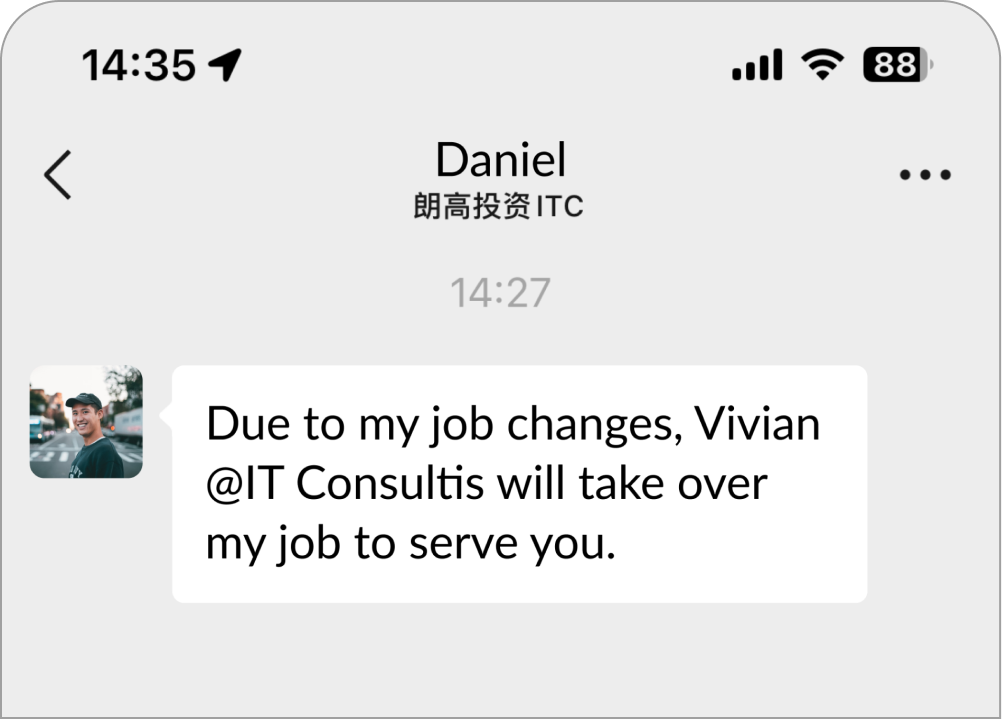
On top of the native WeCom function, the ITC Clienteling Solution can equip brands with the invaluable capability to retain chat history from both the customer service module and staff communication.
This unique feature empowers brands and staff members (where permitted) to gain insights into significant information from past interactions, ultimately elevating their understanding of customer needs and preferences.
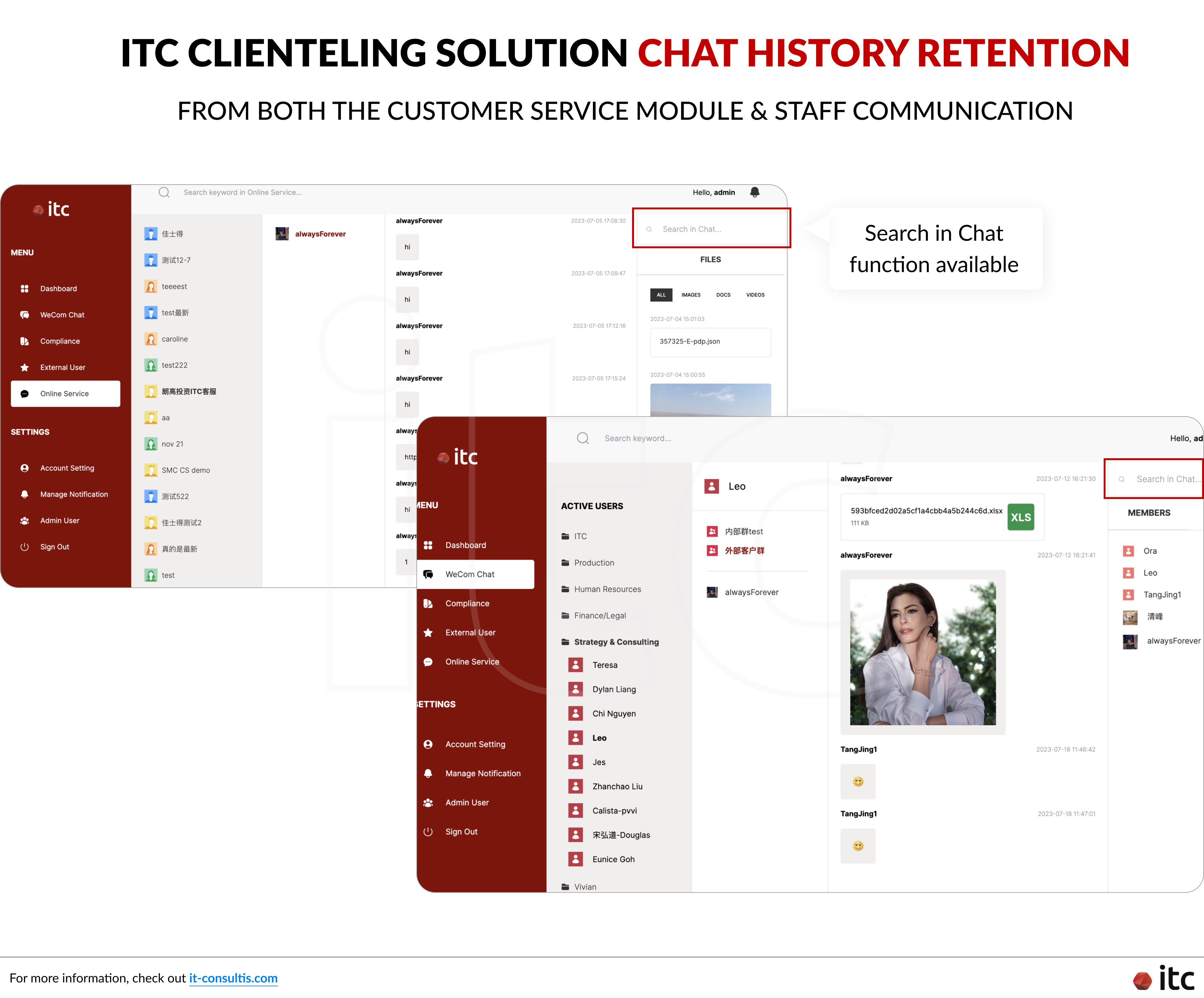
Beyond addressing customer reassignments resulting from employee departures, companies also possess the flexibility to allocate individual customers and groups of existing employees to another staff member.
This feature becomes particularly relevant in scenarios such as store manager reassignments, often referred to as the “on-the-job inheritance function”. Furthermore, the process of in-service inheritance does not interfere with the mechanisms for resignation inheritance.
5. WeCom Moments
We live in an attention economy where brands are increasingly looking to increase visibility. As the market gets crowded with more players and platforms, customer acquisition costs are rising considerably, especially on Public Traffic platforms like Xiaohongshu, Douyin, Weibo, and Tmall.
Adding to this challenge, a recent WeChat update has altered the default settings, muting and reducing notifications for Official Accounts (OAs). As a result, OA articles are having a much more difficult time securing visibility, with an open rate of only a little over 5% in 2022.
On the other hand, it is reported that the majority of WeChat users access WeChat Moments every time they open the app.
In this context, WeCom Moments are emerging as a bright alternative for brands seeking to capture users’ attention, enabling direct engagement with customers right through their personal feeds. This free strategic approach represents a valuable means for brands to execute one-on-one, targeted interactions with users.
For instance, consider the case of Moschino, which successfully employed WeCom Moments in its brand ambassador announcement in July 2023. This campaign effectively drove:
- Customer engagement with sales associates’ WeCom accounts, as customers sought exclusive wallpapers
- Traffic to the brand’s growing WeChat Official Account
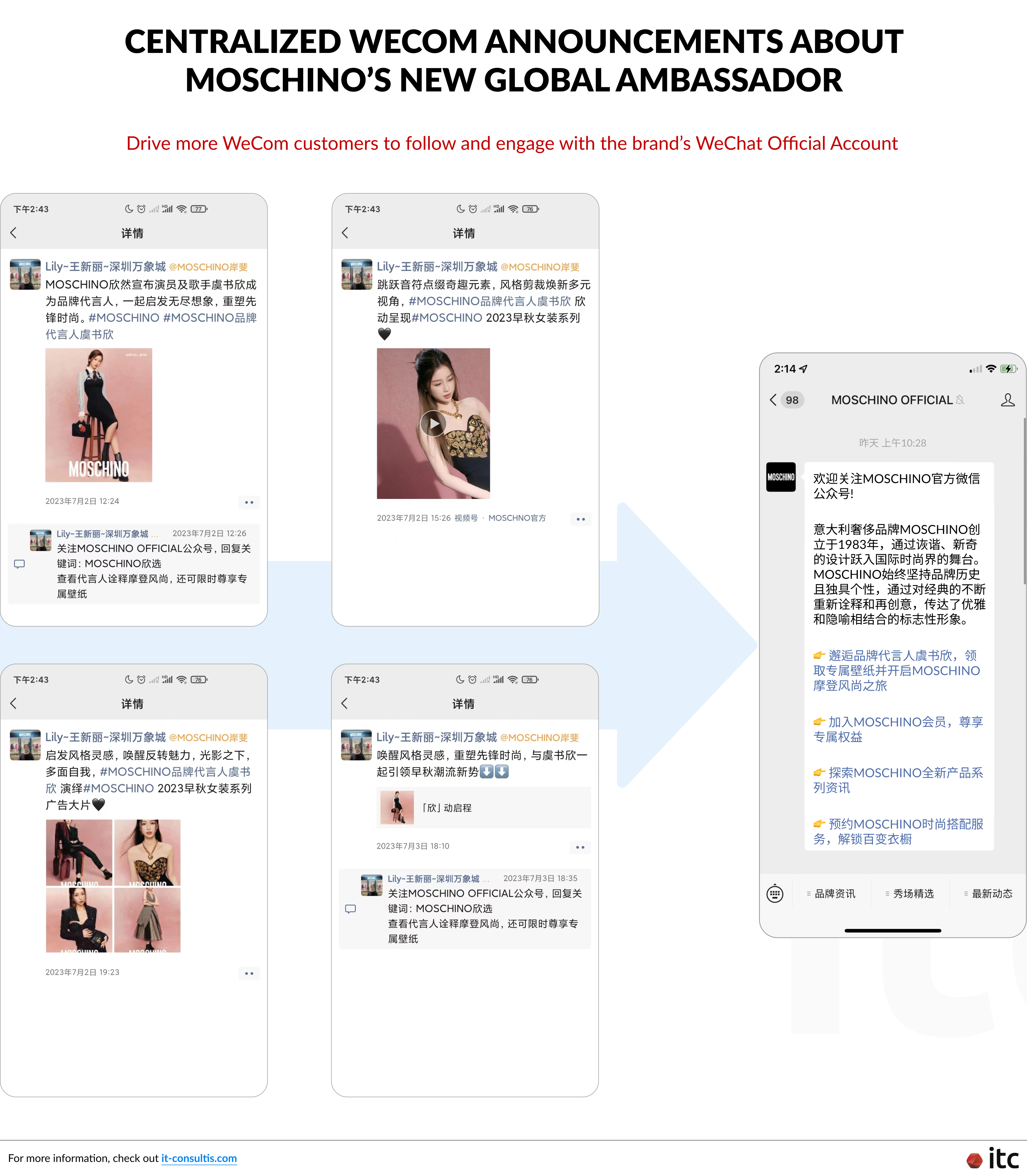
Other than real-time visibility on their Moments feed, customers can also view all the historical WeCom Moments once they add or check out a sales associate’s WeCom profile.
On the brand’s side, admins can access data on customer engagement with the WeCom Moments, including metrics such as the number of views and comments. Furthermore, as customers browse through a Moments update, WeCom can promptly dispatch notifications to the corresponding salesperson to ensure timely and swiftly follow-ups on customer inquiries or comments.
To Wrap Up
In the dynamic Chinese market, dominated by the super app WeChat, WeCom emerges as a strong ally for brands, aiding in direct communication with customers and elevating brand visibility.
However, WeCom alone is only a mere tool. While over 10 million businesses and organizations have implemented WeCom by 2023 (WeCom Whitepaper 2023), only a few have managed to harness its full potential. This is often because they struggle to connect, integrate, adapt, secure, and properly educate and train their management and execution staff.
To maximize the values of WeCom as the solution to their multifaceted clienteling challenges, brands need the right strategy and execution playbook to address them with precision and personalization and offer a holistic view to management, especially in the context of customer management. This approach ultimately leads to enhanced customer loyalty, increased sales, and an improved overall brand experience.





![[WeCom x ITC] Achieving Digital Transformation with Best-in-Class WeCom Clienteling [WeCom x ITC] Achieving Digital Transformation with Best-in-Class WeCom Clienteling](https://assets.it-consultis.com/_next/image/?url=https%3A%2F%2Fit-consultis.com%2Fapp%2Fuploads%2F2023%2F06%2FCover-Summary-article-1024x578.png&w=3840&q=100)